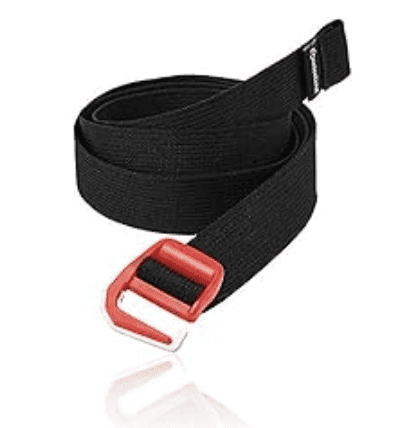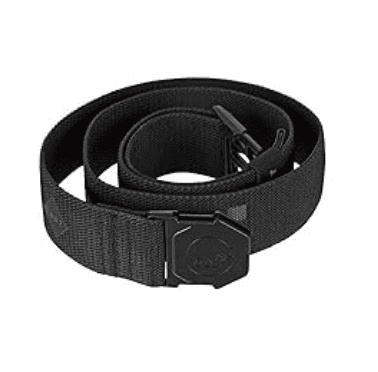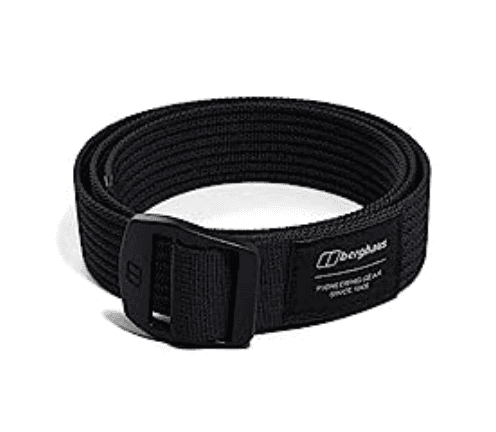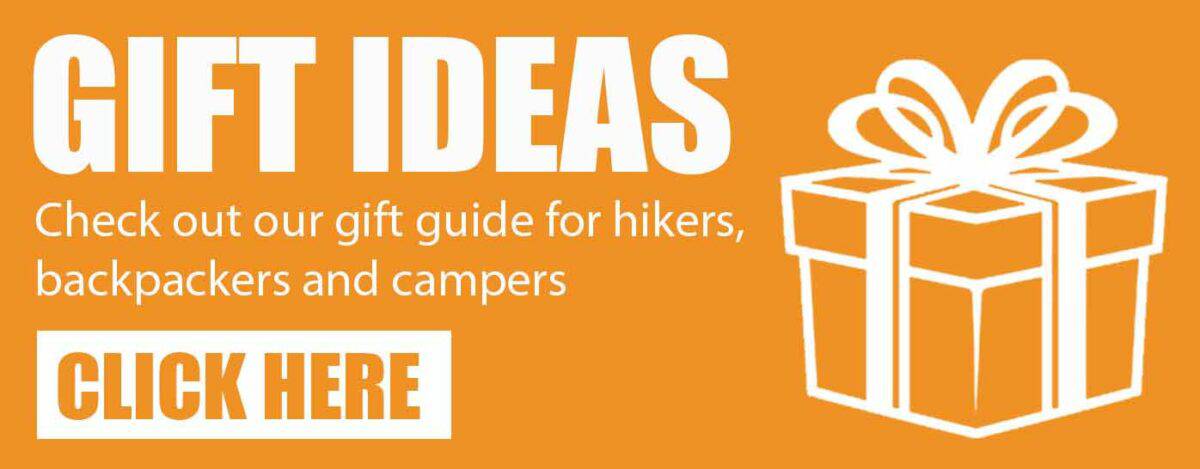We truly believe that being able to focus on what’s around you and eliminating as many distractions as possible will allow you to get the most out of your hiking experience. We all have our different reasons for hitting the trail but one thing that really hinders your experience is something like a piece of uncomfortable or ill-fitting kit getting in the way of you being truly in the moment. Sure, your boots and backpack are some of the most important and obvious pieces of outdoor clothing to get right, but sometimes the less obvious things can actually have a big impact as well.
Nobody wants to be pulling their trousers up all day when they’re on the trail – and this isn’t even down to having trousers that are massively oversized! Your waist can vary a lot through the time of a hike. You can bloat at different times and this can leave your trousers that were otherwise just right feeling too loose. A good belt has become somewhat of an essential and can make a really big difference to your comfort whilst out on the trail. But what makes one belt better than the majority of belts out there and which of the practically millions of seemingly similar options out there are worth your money for the average price you’ll pay?
Our fuss-free, honest guide to the best hiking belts out there puts twelve of our favourites through their paces so you can find the right hiking belt for your needs.
Editor’s note: This article is part of our guide to the very best options in hiking belts for 2024, be sure to check out the rest of this guide for our top buying tips:
At a Glance: Best Belts
Product | Arc'Teryx Conveyor Belt 38 | Jukmo Ratchet Belt | Black Diamond Diamond Mine Belt | Amazon Eono Lightweight Nylon Belt | Montane Loop Belt | Fjallraven Canvas Brass Belt | Mammut Alpine Belt | Berghaus Inflection Belt | Jukmo Tactical Belt | Fjallraven Keb Trekking Belt | Under Armour Webbing 2.0 Belt | Kemisant Stretchable Tactical Belt |
Buying Options | ||||||||||||
Pros | Materials meet Bluesign® criteria, Wider, heavy duty design | Thicker nylon webbing, sturdy design, accessible sizing | Machine washable, simple to use with cold hands and gloves | It's cheap! Good build | Ultralightweight, reasonable price | Textured finish helps the buckle grab fabric well for secure fit, large distinctive logo | Striking looks, low profile buckle for comfort | Simple design built to last, minimal aesthetic | Striking design, Available in wide range of sizes | Lightweight, designed specifically for hiking and trekking | A good looking belt, reversible webbing gives two different color options in one | Variety of lengths and easily cut to size, low profile smooth buckle |
Cons | Priciest in review, sizing can be inconsistent | Complex buckle could jam over time, buckle coud snag on other garments design and color choices may seem dated to some | Basic color range, lacking in size options | Design is basic, plastic buckle may not last | One length, buckle can be fiddly with cold hands | Pricier than some others, brass buckle could scratch easily | Pricey, maximum length of 110cm | Only one length and color option, pricey | Complex buckle may create weak point, Military look isn't to all tastes | Costly, There may be some long term durability issues | More fashion and not as optimised for the outdoors | More complex buckle could jam over time, limited to two colors |
Color | Black, nightshadow, caper, carbon steel, iron oxide, aramon | Black, blue, coffee, cayote, green and grey | Black, grey | Black | Black - red buckle, kelp green, shadow | Dark navy, black and mountain grey | Black, granite, sundown | Black | All grey/black buckle, black, grey, blue, coffee, coyote, green | Black, dark olive with matching buckles | Reversible webbing - black and dark blue | Black or brown |
Length | S= 47.1in/1060mm, M= 45.7in/1160mm, L= 51.2in/1300mm | 41'/104.1cm, 45"/114.3com, 61"/154.9cm | S=109.2CM/43', M=115.57CM/45.5", L=125.73CM/49.5" | 130cm/51in | One size | 120cm/47in | 110cm/43.3in | One size | 5x length options from XS to XXL | 120cm/47in | One length | 30-34in/76.2-86.4cm, 34-38in/86.4-96.5cm, 38-42in/96.5-106.7cm, 42-46in/106.7-116.8cm, 46-50in/116.8-127cm |
Width | 3.8cm | 3.3cm | 3.8cm | 3.8cm | 3.8cm | 3.8cm | 3.8cm | 3.5cm | ||||
Material | 98% nylon, 2% polyester, metal buckle | Polyamide webbing, zinc alloy buckle | Polyester webbing, aluminium buckle | Nylon, plastic buckle | Polyester, plastic buckle with metal reinforcement | Aryclic, metal buckle with brass finish | Polyester, plastic buckle | Polyamide, aluminium buckle | Polyamide with aluminium buckle | Elasticated polyester webbing with plastic buckle | Polyester with metal buckle | Nylon stretchable webbing, leather tip on strap with zinc buckle |
Each Hiking Belt in Detail:
Fjällräven Canvas Brass Belt
Read our full review of the Fjällräven Canvas Brass Belt
Pros/ Reasons to Buy:
- Textured finish helps the buckle grab fabric well for secure fit
- Large distinctive logo
- Easily shortened
Cons / Reasons to Avoid:
- Pricier than some of the other belts reviewed
- Brass buckle could scratch easily
This Canvas Brass Belt from Fjällräven is easily shortened in length to make it a great flexible option to get the right fit. The high quality and finish of the metal buckle with brass finish should see this belt lasting a long time. In our opinion, one of the best belts in our line up.
We really like this trekking belt, it’s stylish, well made and feels like it’ll last a long time. The adjustability and flexibility of the belt also works well if you need to layer up some days more than others and different times of the year, making it a more flexible option and overall versatile belt. At 4cm in width, we think this belt is a good sturdy option that is unlikely to dig into your waist for an extra level of comfort whilst doing the job it’s meant to do well.
Mammut Alpine Belt
Read our full review of the Mammut Alpine Belt
Pros / Reasons to Buy:
- Striking looks
- Low profile buckle will be comfortable over prolonged periods
Cons / Reasons to Avoid:
- Pricier than some of the other belts reviewed
- Maximum length of 110cm means it won’t be suitable for those needing a longer belt
This is certainly more distinctive than the majority of outdoor belts available, but there’s far more to it than just blingy looks: it’s well designed and practical too. Exactly what we’ve come to expect from Mammut.
If Versace made hiking belts… well, that might be a slight exaggeration, but this belt is certainly striking, especially in the Sundown (pink/magenta) colourway. With a prominently embossed Mammut logo on the buckle and not so subtle branding on the webbing, this belt is certainly an eye-catcher. But it’s also very thoughtfully designed and the low profile buckle is unlikely to snag in other garments or ‘dig in’ when you sit down and will be comfortable when worn beneath the hip band of a large backpack. On the downside, the belt is only available in one length – 110cm – making it unsuitable for people wanting a longer length hiking belt.
Berghaus Inflection Belt
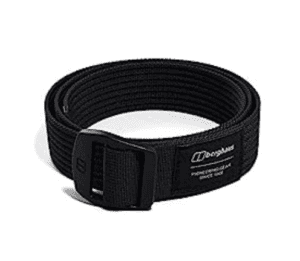
Read our full review of the Berghaus Inflection Belt
Pros / Reasons to Buy
- Simple design means this will last
- Minimalist styling with just a touch of branding is very nice
Cons / Reasons to Avoid
- Only one length and colour option
- It’s a little pricey!
Berghaus have a well-earned reputation for creating sensibly designed, no nonsense gear and this hiking belt is no exception with its simple, hard-wearing design and understated good looks.
Henry Ford once famously said you could order his cars in any colour you wanted, so long as it was black, and it seems that someone at Berghaus had this quote in mind when they designed this belt. We think the Berghaus Inflection Belt looks great – it’s understated without being too minimal – but it’s also well made from durable materials that could easily stand a lifetime of use. Berghaus have built their reputation on making great quality, sensible gear that doesn’t ‘announce’ its presence as much as some of their competitors do. Whilst other outdoor brands have crossed over into the fashion market, Berghaus are still exclusively committed to producing functional outdoor gear and this belt is no exception. Where the inflection is concerned, they’ve created a really versatile belt. We think this would be one of the best belts for backpacking we’ve reviewed too.
Amazon Eono Lightweight Nylon Belt
Read our full review of the Amazon Eono Lightweight Nylon Belt
Pros / Reasons to Buy
- It’s cheap – in fact this is the cheapest belt in our review
- Despite its low price, it still makes use of good quality components
Cons / Reasons to Avoid
- The design is a little too basic
- The plastic buckle may impact long term durability
This nylon hiking belt is unashamedly a budget choice: It’s by far the least expensive belt in this round up. However, the Eono belt is well specified and hits above its weight in terms of features and is one of the best hiking belt budget options out there.
Amazon’s own brand Eono Lightweight Nylon belt makes no bones about being a budget friendly option but it’s also a really versatile belt for the money. It’s described as a work belt, but we think it’s equally suitable as an outdoors belt and ticks many of the boxes for a good hiking belt. Despite the budget price, the belt comes with a POM buckle manufactured by YKK – that’s a name you’ve almost certainly seen on zippers and they are the world largest manufacturer of fasters with a reputation for making good quality products. The belt has a very minimalist all-black design and looks good enough to be a fashion belt. We also have to mention the price point again: This is a big deal as the Eono is the least expensive product in this round up by a long way and that alone might be the deciding factor for many buyers. It also presents a great option for those looking for belts without metal buckles.
Montane Loop Belt
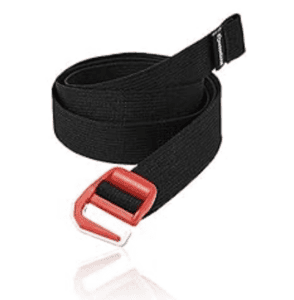
Read our full review of the Montane Loop Belt
Pros / Reasons to Buy
- Ultra lightweight – by far the lightest belt we’ve reviewed
- Fair price
Cons / Reasons to Avoid
- Very basic design
- Hook and loop closure can be fiddly – especially with cold fingers
Outdoor specialist Montane deliver the ultra-lightweight Loop Belt, an ideal option for long distance hikers and trail runners where every last gram matters – one of the best backpacking belts.
Montane have a reputation for creating products that cater to the more extreme needs of the outdoor community. The Loop Belt is definitely such a product and at 30g is by far the lightest hiking belt we’ve seen – a great backpacking belt. It will no doubt appeal to those heading off on self-supported hikes, long distance treks and to those involved in outdoor sports. If you’re doing something where you need to justify every last gram you carry, this is the best lightweight belt for you! However, this outdoors belt comes with compromises and the ergonomics of the belt are not the best we’ve seen.
Jukmo Tactical Belt
Read our full review of the Jukmo Tactical Belt
Pros / Reasons to Buy
- Striking design
- Available in a wide range of different sizes
Cons / Reasons to Avoid
- Complex buckle mechanism may be a weak point
- Military looks may not be to everybody’s taste
The Jukmo Tactical Belt definitely caters to those who like the military aesthetic, but it still has plenty to offer hikers including a wide range of different sizing options.
The Jukmo Tactical Belt certainly has a strong military feel about it and the very distinctive ‘X’ shaped buckle might not be to everyone’s taste, but it offers a quick and secure opening and closing mechanism, promises quick adjustment and is available in a wide range of different colour and lengths. At its fairly average price within our hiking belts line up, we think this belt could be a good one in the running if you’re looking for flexible sizing or looking for a utility belt for hiking.
Fjällräven Keb Trekking Belt
Read our full review of the Fjällräven Keb Trekking Belt
Pros / Reasons to Buy
- Lightweight hiking belt
- Designed specifically for hiking and trekking
Cons / Reasons to Avoid
- Costly
- There may be some long-term durability issues
The second Fjällräven belt we’ve reviewed, the Keb is less of a fashion belt and aimed more at the serious hiker. It’s a compelling, lightweight option, but it comes at a cost.
Most people think of Fjällräven as a fashion brand – walk around any big city and you’ll see plenty of stylish people carrying their backpacks. But the brand also has a long history of making serious outdoors gear and the Keb Trekking Belt falls into this category. It’s lightweight and sensibly designed, but this comes at a relatively high price and some of the material choices may lead to long-term durability concerns, however, it’s still one of the best outdoor belts out there right now.
Under Armour Webbing 2.0 Belt
Read our full review of the Under Armour Webbing 2.0 Belt
Pros / Reasons to Buy
- A good looking belt
- Reversible webbing gives two different color options in one
Cons / Reasons to Avoid
- It’s definitely more of a fashion belt and is not ‘optimised’ for the outdoors
- The relatively complex buckle may wear out over time
Under Armour are one of those brands that exists in two worlds: they make well regarded technical clothing, but they are also increasingly seen as a fashion brand.
The Webbing 2.0 Belt feels to us like it belongs more in the fashion world – prioritising looks over function. Despite this, it is still a good choice at a fairly average price within our line up for the trail and its looks mean it will be just as much at home on a casual outfit at the end of your hike.
Jukmo Ratchet Belt
Read our full review of the Jukmo Ratchet Belt
Pros / Reasons to Buy
- Thicker nylon webbing than many other belts makes for sturdier design
- Variety of lengths mean more accessible sizing and one of the best adjustable belts out there
- Styling suitable for a variety of uses – this belt would work well as a work belt and a hiking belt combined, meaning less need for different products
- The excess of the belt goes behind the main belt fabric, meaning any excess is less obvious and looks better
- Low cost and fair price for what you’re getting
Cons / Reasons to Avoid
- More complex buckle could jam over time from dirt, sand etc
- May not be suitable for narrower belt loops
The thick nylon webbing on this belt provides a very strong and durable solution for a multitude of uses. In our opinion, a top contender for best webbing belt and also best heavy duty belt.
The Jukmo Ratchet Belt is a great option for anyone looking for a hiking belt that can be used for a multitude of purposes – as it’s rugged for the outdoors and stylish enough for work and around the office. The belt comes in a range of natural, earthy colours which we think offer something quite understated alongside a sturdy belt that seems like it’s really built to last – we really like this synthetic belt. Jukmo also talk about how this belt has stretch, so if you’re looking for an elastic belt, this one may well tick the boxes for you.
Kemisant Stretchable Tactical Belt
Read our full review of the Kemisant Stechable Tactical Belt Belt
Pros / Reasons to Buy
- Variety of lengths, going longer than a lot of other suppliers and easily cut to size for best fit
- Looks low profile with smooth buckle to avoid digging in
Cons / Reasons to Avoid
- More complex buckle could jam over time from dirt, sand etc
- Limited to two color options (black and brown)
With the option up to 50 inches, this best gives a great longer length solution
The Kemisant Outdoor Belt is a great option for those looking for a longer length hiking belt – with sizing up to 50 inches/127cm. The belt comes in black and brown (we wish it came in a better variety of colors) and is a fairly no nonsense hiking belt that looks stylish and low profile at the same time. The nylon belt construction offers stretch too – giving even more flexibility, freedom of movement and a sense of give whilst wearing, which could be really comfortable for prolonged use on the trail over the course of a day or multiple days. Given that the buckle is made from zinc it benefits from being hard to damage and an easy release mechanism makes use with cold hands or gloves easier. However, the more complex buckle does leave space for more to malfunction over time.
Black Diamond Diamond Mine Belt
Read our full review of the Diamond Mine Belt
Pros / Reasons to Buy
- Machine washable, so easy to look after
- Solid buckle with minimalist design and easy to use
- Simple design is easy to use with cold hands or gloves
Cons / Reasons to Avoid
- Fairly basic range of colours
- Lacking in size options
The Diamond Mine Belt is inspired by climbing and climbing harnesses for a lightweight easy to use outdoors belt made from nylon.
The Black Diamond, Diamond Mine Belt is a great belt for those with a love of climbing and takes the same feel and design as a lot of Black Diamond’s famous climbing hardware to create a belt that feels like a nice statement in terms of hiking belt designs. It has a very simple design with a rounded buckle that is unlikely to dig in, making it very comfortable to wear. The belts simple design also means that it is easy to use when you’ve got cold hands or are wearing gloves – something we feel is really worth consideration! An all round great and one of the best nylon belts out there.
Arc'teryx Conveyor Belt 38
Read our full review of the Arc’teryx Conveyor Belt 38
Pros / Reasons to Buy
- Wider, heavy duty design means more comfort
- Comes in a variety of colours and sizes, looks stylish
- Materials meet bluesign® criteria
Cons / Reasons to Avoid
- Tops as the priciest belt in our review
- Sizing doesn’t seem to be consistent
The Conveyor Belt presents a wide heavy duty belt from outdoor staple Arc’teryx and gives a good option that combines durability, style and sustainability credentials. It’s one of the best durable belts out there and one of our top picks for best outdoor belt.
The Arc’teryx Conveyor Belt 38 comes in a variety of sizes (S = 41.7in/1060mm, M = 45.7in/1160mm, L = 51.2in/1300mm) and a variety of colors (we particularly like ‘Oracle’). Made of synthetic fibres (a mix of 98% nylon and 2% polyester, this belt claims to provide enhanced performance and durability. We think this is actually a really stylish looking belt and would work well on the trail and about town – meaning you need to buy less stuff overall! A great belt for hiking pants and casual trousers too. We also love that the Arcteryx Conveyor Belt has been made with sustainability in mind and meets the bluesign® criteria for materials used – especially important when it comes to plastics. It’s not the cheapest belt out there, but we think it really does punch above its weight and in our opinion is one of the best web belts out there!
Hiking Belt Buying Guide
When it comes to outdoor clothing, we believe it’s possible to get too bogged down with endless detail which takes away from you being able to make the decision of which product to buy that is right for your needs. So, our aim is to make this as easy for you as possible. Below we’ve outlined some of the most important areas to consider when it comes choosing the best hiking belt for you. These are written in brief – check out our guide on how to choose the right hiking belt for more information.
Price
The price range for hiking belts can vary massively, and this is usually down to the brand name, material and construction. For example, you’ll generally find that leather belts are more costly than nylon or polyester belts as it is a more expensive base material. However don’t let a higher price point make you think that the belt you’re looking at is a better option. Of course, cost is the most important decision if you need to work to a set budget, but choosing the most expensive belt isn’t necessarily going to give you the best belt for you. We genuinely think that more important than price when making a decision, is to consider the weight, material and length of the belt, plus the buckle design that you’ll find easiest to work with.
Material – Type and Style
What materials do you need to look out for when deciding upon the best belt for hiking? What should you be looking for in hiking belt designs? You might think a traditional leather belt with stainless steel fittings would be a good choice, but, whilst these belts might look good, they tend to be heavy, poorly adjustable and require maintenance to keep the materials in top form. With this in mind, most hiking belts are now made of lightweight, hardwearing and maintenance-free synthetic materials and, when they do feature metal it’s usually lightweight and corrosion resistant aluminium.
In terms of the main band, the majority of synthetic belts are made from either nylon (also called polyamide) or polyester ‘webbing’, which are popular material choices due to their durability, but they each have their own qualities when it comes to which belt to choose, here are some of the pros and cons of each:
Nylon
Pros:
- Scratch and cut resistant
- Wrinkle resistant
- Doesn’t shrink
- Dries quickly
Cons:
- Can pile and get ‘bobbles’ on the surface which can affect the aesthetic of the belt
- Absorbent so can hold onto body odour
Polyester
Pros:
- Resistant to heat, chemicals etc
- Resilient to scratches and cuts
- Resistant to dirt, fungus etc
- Inexpensive material, meaning price point is often cheaper
Cons:
- Retains heat
- Not always eco friendly
- Low absorbency, meaning it may hang onto odour for longer
Buckle Style
The buckle is probably the defining part of a belt and it’s the key feature where each of the products we’ve reviewed truly differentiate themselves from each other. The choice of buckle has some big implications on the wearability and utility of the belt, so it’s good to know the options. However, not all buckles are created equal and how a manufacturer implements a design is also very important and the choice of materials and how they are combined can also impact how well a buckle functions. Below are some of the most common buckles you’ll come across, many of which are referenced in our guide to the best belts for hiking out there right now:
Friction Buckle: This is a very simple design – similar to what you’ll find controlling the length of the straps on your rucksack. Simplicity is this design’s greatest strength as it allows for very robust designs. These buckles are also relatively quick to adjust and offer very fine control of the belt’s tightness. However, they also require the strap to be completely unthreaded from the buckle to fit and fully remove the belt. This is a tedious and fiddly set of actions – especially so if you have cold hands, so this type of buckle isn’t a great choice if you regularly need to completely remove the belt (for instance, if you’re swapping it between trousers). So, the key downside of this design is that it limits versatility. Another possible downside is that the tension can ‘slip’ in a friction buckle meaning that you may have to re-tighten the belt in use. On a well designed belt, you may only need to do this occasionally, but a poorly designed friction buckle may only keep its tension for a few steps and this can be incredibly frustrating with the belt becoming more of a problem than a solution. A variant on the friction buckle is found on ratchet or ratcheting belts. A ratcheting belt functions a bit like a zip tie – allowing the buckle to be progressively tightened, but requiring it to be completely released to loosen it.
Quick release buckle: These allow for quick fastening and also release. This fastening seems to be the most popular on military style or so-called tactical belts. These fastenings are often designed so they are great if you’re wearing gloves as well. The downside of quick release buckles is that they are a relatively complex mechanism that often comprise several parts if they are made from metal and delicate prongs if made from plastic. This relative complexity is a source of weakness in the design and makes these buckles prone to wear and tear from the elements, repeated use or just accidental damage. It’s also worth noting that a quick release is simply a way of opening and closing a belt and that they need to be combined with another mechanism – usually either a friction of flip-top buckle – to control the length of the belt. Straight away, this adds another level of complexity to an already complex mechanism. So, bulk and potential long-term durability issues are the downside of this design.
Flip-top or flip closure buckle: You’ll find this kind of fastener quite a lot on belts that are meant for casual wear too. These have a mechanism similar to the seatbelt in an airplane where you lift a lever to both open and close and control the length of the belt. They are simple in use and offer fine control of the belt’s length as there are no holes required in the belt. However, they are prone to ‘slip’ on smooth belts which can lead to them needing to be regularly tightened, so if this is the kind of buckle you decide to go for, look for a belt material that seems more textured as this will give the buckles teeth more purchase. Also, be aware that this type of buckle can have protruding surfaces that can be a source of discomfort – especially on more fashion style belts.
Tongue buckle: This is one of the most traditionally used buckles when it comes to belt design and is very easy to use. You likely know well what a tongue buckle looks like – if you visualize a belt, it probably has this kind of buckle. A tongue buckle has a frame, bar and prong and the prong sits in holes in the belt. This type of fastening requires holes in the belt to work, so very precise control of the length of the belt isn’t possible. The prong can also become bent and catch in other garments or accessories. That said, the tongue buckle is a simple and time-tested solution.
Hook and eye buckle: Another super-simple design that allows for long lasting and often very lightweight designs. In this case a hook simply connects with a loop or eyelet to secure the belt. This can take two forms: the loop is either formed in the fabric at one end of the belt and it’s joined with a shaped hook, or you can have two flat plates with a hook and eyelet in between them. Whilst this design is simple and also can be engineered to be very light, it can also be quite fiddly to operate – and that’s especially the case with cold hands or when wearing gloves. Also, the hook and eye mechanism is only a closure and the hook part will typically be combined with a friction buckle to control the length of the belt.
Weight & Length
When it comes to length, you want to choose based on which model is going to give you the closest to your waist size as possible. Whatever length of belt you need, we’d really recommend actually measuring your waist and not just going based on your normal clothes sizes. It’s a good idea to make sure there isn’t too much excess material when your belt is fastened – we’d recommend choosing something where you have room for flexibility with tightness and no more than really 15cm of excess. The overall weight of a belt really depends mostly on what material is used as well as other details such as the weight of the buckle. Considering a lot of the belts we’ve recommended are made from nylon/are synthetic, the weight of the buckle is likely to be one of the main factors when comparing the different weights of a hiking belt and choosing the best belt for you. All told, none of the belts we’ve looked at are particularly heavy, but some are less heavy than others and the Montane Loop Belt in particular stands out as the best lightweight belt we looked at and this is going to be a great choice if you’re heading off on the type of long-distance hike where every gram of weight you can save counts. You’ll also want to keep an eye on the width of the belt too – if you have narrower belt loops for example, you’ll want to make sure this is going to fit before you purchase.
Durability
What makes something the best web belt or nylon belt? Of course, you never know if something is going to ‘last a lifetime’ but you can also try and make as informed a decision as possible. We’d recommend going for belts with less complicated buckle systems, where there is less likely to go wrong or get jammed from constant use. It’s about looking at where you’re going to wear the belt – what kind of conditions you hike in. For example, some of the more simplistic designs like the Arc’Teryx Conveyor Belt 38 might be the best belt for those hiking in conditions where you are more exposed to sand. A more technical belt buckle which is likely to pick up sand etc, would be better suited to forest hikes, like the Fjällräven Keb Trekking Belt. A hiking belt isn’t a huge investment, but it’s not something you want to have breaking whilst you’re out on the trail as this is likely to leave you having to pull your trousers up through your hike. Obviously, we’re all individual, so we’d recommend trying out your new hiking belt for a couple of shorter walks and hikes first, before wearing on something long to make sure everything is working properly and isn’t going to interfere with your enjoyment.
Conclusion
We know that there are a lot of reviews out there that get lost in heavy detail when it comes to outdoor clothing – and sometimes it can feel over complicated. Yes, any piece of kit is an investment, but we don’t feel that choosing the right hiking belt, or in fact any hiking kit should be a difficult decision. It should be a decision made on fact and looking at the most informed ideas of what is best and weighing up the pros and cons. We see gear as an enablement – it allows you to go further and see things you may not be able to otherwise, and that gear is important. When it comes to the best hiking belts, we wanted to create a guide for what to consider and make it much easier for you to decide which one is best for you and your needs without getting lost in endless information that makes it hard to make a decision.
Disclaimer: This article contains Affiliate Links. You won’t pay any more for buying through these links, but we may receive a commission from any purchases made through them. As an Amazon Associate, I earn from qualifying purchases. If you choose to support us by buying through our links, we thank you as it helps us to continue providing the resources we do to help you enjoy the outdoors more!





